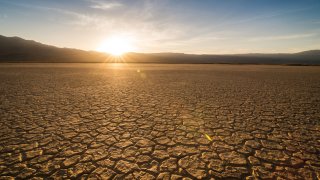
Cracked mud stretches across sections of Panamint Valley.
Temperatures are about to soar in Southern California on a significant date in the history of extreme weather.
It was 107 years ago Friday that the sweltering desert location of Furnace Creek in Death Valley set a world record for highest air temperature at 134 degrees.
Death Valley's high temperatures are influenced by the depth and shape of Death Valley. The valley is a long, narrow basin below sea level, with high, steep mountain ranges.
Additionally, the dry air and limited plant coverage allows sunlight to heat up the desert surface.
The National Park Service said heat radiates back from the rocks and soil, and becomes trapped in the valley.
Here is a look back at some dramatic shots of the hottest place on Earth.